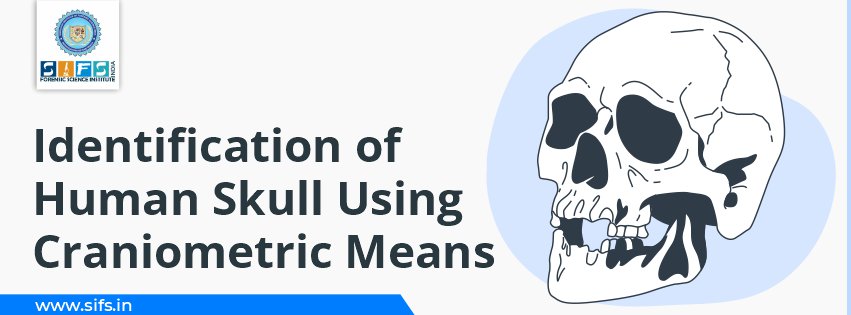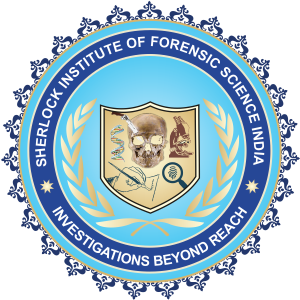- Call Us: +91 7303913002
- Email Us: education@sifs.in
Identification of Human Skull Using Craniometric Means

BY SIFS India | January 04, 2025
Identification of Human Skull Using Craniometric Means
Craniometry is a branch of anthropology and basically as the word suggests it relates to “cranium” which means “the bone inside the head”.
This is used in the field of forensic sciences in order to gain information about an individual in cases involving the identification of a human skull.
The process of identification of the human skull involves the identification of firstly the species confirmation followed by the sex, age, and race of the individual. This is done with the help of the enormous study done in the field of craniometry.
The study of the human skull which will help us in its identification involves complete knowledge which mainly constitutes morphological and anatomical structure, bones, craniometric landmarks, sutures, specific features like the location of the foramen magnum, orbits, types of teeth (Odontology), and many more.
Craniometry is not only confined to the identification of the human skull but it has a wide approach in modern times which involves the examination of the brain of a corpse and also imaging techniques like MRI.
It also plays a vital role in facial reconstruction (A technique in which a face is recreated from its skeletal remains in order to get proper identification of a skull and this is done with the help of measurements of the skull that is based on certain reference points).
The structure of the skull is affected by environmental factors and the location where an individual lives despite the fact that it is an inheritable feature.
This is observed as people from different countries possess differences in the morphology of the skulls. Many ancient theories and philosophies have been proved wrong by recent research.
Introduction to Craniometry Analysis
Craniometry as the word suggests refers to the science that deals with the measurement of the cranium i.e. the most important part of the skull along with the facial structure and mandible (mainly the measurements of the dry bone) in order to determine the species, race, sex, age, etc. of any individual based on the characteristics found in a skull that is encountered.
The face is the part of the body that gives a unique identity to any living being and serves as a means of identification.
The human face in due course of time during evolution is regulated by all the various mechanisms like physiological, anatomical, and embryological.
Therefore this study has served as the most important and productive aspect in doing the comparison between the human skulls with that of fossil hominids and thereafter interpreting the history of evolution.
It is a subfield of anthropology (that means the study of the measurement of the human body).
The technique for getting the measurements to come under osteometry in which the measurements of the different bones present in the body are taken including the skull.
This technique has been used successfully in the estimation of the race, sex, age, and stature of an individual collectively known as “Big Fours” of the eminent field of Forensic Anthropology.
The process of identification of the human skull involves the identification of firstly the species confirmation followed by the sex, age, and race of the individual.
This is done with the help of the enormous study and complete knowledge which mainly constitutes morphological and anatomical structure, bones, craniometric landmarks, sutures, specific features like location of the foramen magnum, orbits, types of teeth (Odontology), and many more.
Craniometry is widely used nowadays as a means of identification in the field of forensic science to solve cases related to the identification of an unknown individual through the help of a skull.
After getting all the proper measurements, the forensic examiner becomes able to interpret the degree or percentage of similarity and differences.
This helps in finding out the identity and thereby provide a lead in the process of solving the case. In cases related to death due to head injury, one can also determine the cause of death by analyzing the deformations in the cranium.
Besides its contribution in forensic science, craniometry is also being used for identification in situations like natural calamities including floods, fire, earthquakes, and any unfortunate incident including war cases, plane crashes, accidents (train or road).
Identification Procedure
Being a vast stream within itself, craniometry constitutes numerous theories and philosophies. The main and primary objective of conducting this research is to aim at the “Identification of Human Skull using Craniometric Means” and reach a particular conclusion of how to identify accurately the human skull with the help of various parameters and techniques. This can be performed with the in-depth study of certain features i.e.
1. Location of the foramen magnum.
2. Location of the orbit of the eye.
3. Types of teeth present.
The skull is one of the most distinguished parts of the body acts as a mode of identification for each and every individual species. The species of an individual can be determined by observing some of the features which we can be easily analyzed by seeing the cranium.
Location of the Eye Sockets or the Orbit of the Eye
By observing the location of eye sockets or orbits we can find out whether the skull belongs to a predator or a prey.
a) In case the eye sockets are in front of the head and are pointed forward then it belongs to a predator because an organism possesses better bin-ocular vision when the eyes are present in front.
b) On the other hand if the eye sockets are present on sideways then it must belong to a prey because an organism possesses better peripheral vision when the eyes are present in the sides.

Figure 1- Difference in the location of eye sockets between predator and prey
Location of Foramen Magnum
The foramen magnum is the point from where the spine enters into the skull. In this, the organism is identified by indicating its movement.
a) In case the hole is present close to the bottom of the skull then it had an upright posture because in this situation the spine of the organism would be vertically aligned as in the case of humans.
b) On the other hand if the hole is present close to the back of the skull then it had a quadrupedal stance (four-legged) because in this situation the spine would be horizontally aligned as in the case of dogs.

Figure 2 - Characterization on the basis of difference in location of Foramen Magnum
Types of Teeth Present
There are four types of teeth namely incisors, canines, molars and premolars present therefore on this basis of shape and number of the different types of teeth one can determine whether the organism belongs to herbivore, carnivore, or omnivore.
a) Herbivores are the animals that eat plants so they only require teeth for grinding so they have flat and smooth molars. Canines are reduced or absent and possess large gaps between the incisors and premolars
b) Carnivores mainly eat meat so they require teeth for piercing and getting a hold of the prey, therefore, they have all four types of teeth. The canines are present in front which is a distinguishing feature.
c) Omnivores eat both plants as well as animals. They also possess all four types of teeth but they can be distinguished from carnivores with the help of molars present because they have molars similar to that of herbivores i.e. flat and broad while on the other hand carnivores have sharp molars.

Figure 3 - Teeth Present in Carnivores, Herbivores, and Omnivores
References
Gatliff, B. (1984). Facial sculpture on the skull for identification. American Journal of Forensic Medicine and Pathology, 5, 327–332.
Yoshino, M., Matsuda, M., Kubota, S., Imaizumi, K., & Miyasaka, S. (2000). Computer-assisted facial image identification system using a 3-D physiognomic range finder. Forensic Science International, 109, 225–237.
Heena Khanna
Lahr, M. M. (1996). The evolution of modern human diversity: a study of cranial variation. Cambridge University Press.

